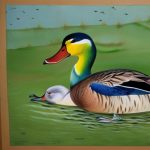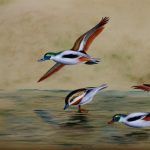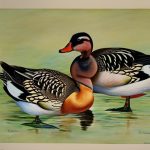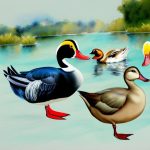Large wild duck breeds are a diverse group of waterfowl that are known for their impressive size, striking plumage, and unique behaviors. These majestic birds can be found in a variety of habitats around the world, from wetlands and marshes to rivers and lakes. Large wild duck breeds are an important part of the ecosystem, playing a crucial role in maintaining the balance of their natural habitats. They are also highly valued by hunters and birdwatchers for their beauty and elusive nature.
Large wild duck breeds come in a wide range of species, each with its own distinct characteristics and behaviors. From the colorful and vocal Mallard to the majestic and regal Muscovy, these birds are a fascinating and integral part of the natural world. In this article, we will explore the characteristics, habitat, behavior, conservation status, and interactions with humans of large wild duck breeds, shedding light on the importance of protecting and preserving these magnificent creatures for future generations to enjoy.
Key Takeaways
- Large wild duck breeds are known for their impressive size and striking physical appearance, making them a popular choice for conservation and hunting purposes.
- These ducks are characterized by their vibrant plumage, long necks, and distinctive beak shapes, which set them apart from other duck species.
- Large wild duck breeds can be found in a variety of habitats, including wetlands, marshes, and lakes, and are known to have a wide range across different continents.
- These ducks exhibit unique mating behaviors, such as elaborate courtship displays and monogamous pair bonding, which contribute to their conservation and breeding efforts.
- Despite their popularity, large wild duck breeds face threats from habitat loss, hunting, and pollution, making conservation efforts crucial for their survival.
Characteristics and Physical Appearance of Large Wild Duck Breeds
Large wild duck breeds are known for their impressive size, with some species reaching lengths of over 30 inches and weighing up to 5 pounds. Their wingspans can also be quite substantial, allowing them to soar gracefully through the air and across bodies of water. These birds are characterized by their striking plumage, which can range from vibrant greens and blues to earthy browns and blacks. Many large wild duck breeds also have distinctive markings on their wings and heads, making them easily recognizable in their natural habitats.
In addition to their size and plumage, large wild duck breeds are also known for their unique physical features. Some species have strikingly colorful bills, while others have distinctive crests or tufts of feathers on their heads. Their webbed feet are perfectly adapted for swimming and diving, allowing them to move effortlessly through the water in search of food. Large wild duck breeds also have excellent vision and hearing, which helps them navigate their surroundings and detect potential predators. Overall, these birds are a stunning example of the beauty and diversity of the natural world.
Habitat and Range of Large Wild Duck Breeds
Large wild duck breeds can be found in a wide range of habitats around the world, from the temperate forests of North America to the wetlands of Asia and Africa. They are highly adaptable birds, able to thrive in both freshwater and saltwater environments. Many large wild duck breeds prefer to make their homes in wetlands, marshes, and swamps, where they can find ample food and nesting sites. Others are more at home on open water, such as lakes, rivers, and coastal estuaries.
The range of large wild duck breeds varies depending on the species, with some being more widespread than others. For example, the Mallard is found throughout North America, Europe, and Asia, while the Muscovy is native to Central and South America. Some species are migratory, traveling long distances between their breeding and wintering grounds each year. These birds are truly global travelers, making their homes in a wide variety of landscapes and climates.
Behavior and Mating Habits of Large Wild Duck Breeds
Large wild duck breeds are known for their fascinating behaviors and intricate mating rituals. During the breeding season, males will often engage in elaborate displays to attract females, including vocalizations, head bobbing, and wing flapping. Once a pair has formed, they will work together to build a nest, usually on the ground or in a tree cavity near water. The female will lay a clutch of eggs, which she will then incubate for several weeks until they hatch.
After the eggs hatch, the parents will care for their young, teaching them how to find food and avoid predators. Large wild duck breeds are highly protective of their offspring, often leading them to safety at the first sign of danger. As the young ducks grow, they will learn essential skills such as swimming and foraging, preparing them for life on their own. Overall, the behavior and mating habits of large wild duck breeds are a testament to their intelligence and adaptability in the natural world.
Conservation Status and Threats Facing Large Wild Duck Breeds
Despite their adaptability, large wild duck breeds face a number of threats to their survival in the modern world. Habitat loss is a major concern for many species, as wetlands and other natural areas are being destroyed or degraded by human development. Pollution is also a significant issue, as contaminants in waterways can harm both the ducks and their food sources. Climate change is another threat, as rising temperatures and changing weather patterns can disrupt breeding and migration patterns.
In addition to these environmental challenges, large wild duck breeds are also vulnerable to hunting and predation. While regulated hunting can be sustainable for some populations, illegal poaching and overharvesting can have devastating effects on duck populations. Predators such as foxes, raccoons, and birds of prey can also pose a threat to nesting ducks and their young. Overall, the conservation status of large wild duck breeds is a complex issue that requires careful management and protection efforts.
Interactions with Humans and Importance of Large Wild Duck Breeds
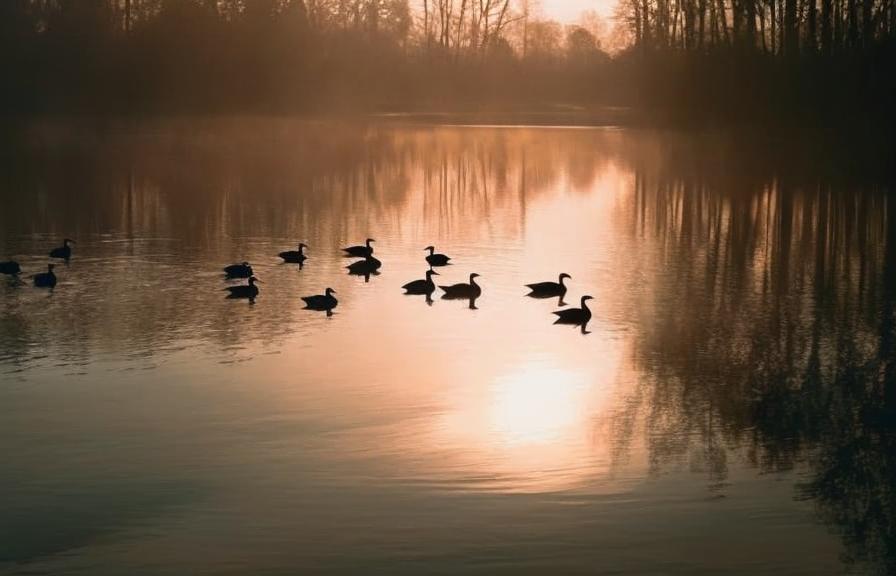
Large wild duck breeds have long been important to humans for both practical and recreational purposes. Throughout history, ducks have provided a valuable source of food for many cultures around the world, with their meat and eggs being highly prized for their nutritional value. In addition to their culinary importance, large wild duck breeds are also highly valued by hunters for sport and recreation. Many people enjoy the challenge of hunting ducks in their natural habitats, using traditional methods such as decoys and calls to attract the birds.
In addition to their practical importance, large wild duck breeds also hold significant cultural and ecological value. These birds are often celebrated in art, literature, and folklore as symbols of beauty, freedom, and resilience. They also play a crucial role in maintaining the health of their natural habitats by controlling insect populations and dispersing seeds. Overall, large wild duck breeds are an integral part of the natural world and hold great significance for humans in a variety of ways.
Efforts to Protect and Preserve Large Wild Duck Breeds
In response to the threats facing large wild duck breeds, conservation organizations and government agencies around the world have implemented a variety of measures to protect and preserve these magnificent birds. One key strategy is habitat conservation, which involves protecting wetlands, marshes, and other natural areas that are crucial for duck populations. This can include creating wildlife refuges, establishing protected areas, and restoring degraded habitats to their natural state.
Another important conservation effort is monitoring and managing hunting activities to ensure that duck populations remain sustainable. This can involve setting limits on hunting seasons and bag limits, as well as enforcing regulations to prevent illegal poaching. In addition to these measures, education and outreach programs are also crucial for raising awareness about the importance of large wild duck breeds and promoting responsible stewardship of their habitats.
In conclusion, large wild duck breeds are a diverse and fascinating group of birds that play a crucial role in maintaining the health of their natural habitats. From their impressive size and striking plumage to their intricate behaviors and mating rituals, these birds are a testament to the beauty and diversity of the natural world. However, they face a number of threats to their survival, including habitat loss, pollution, climate change, hunting, and predation. Efforts to protect and preserve large wild duck breeds are crucial for ensuring that these magnificent birds continue to thrive for generations to come. By working together to conserve their habitats and manage human interactions with these birds responsibly, we can help ensure a bright future for large wild duck breeds around the world.
If you’re interested in large wild duck breeds, you might also want to explore the fascinating world of chicken breeding. Poultry Wizard’s article on “how long for chicken eggs to hatch naturally” provides valuable insights into the natural hatching process, offering useful tips for breeders. Understanding the incubation period is crucial for successful hatching, and this article delves into the details. Check it out here.
FAQs
What are some examples of large wild duck breeds?
Some examples of large wild duck breeds include the Mallard, the Muscovy duck, the Pekin duck, the Rouen duck, and the Cayuga duck.
What are the characteristics of large wild duck breeds?
Large wild duck breeds typically have a robust and sturdy build, with a wide and flat bill, and strong legs and webbed feet. They often have a colorful plumage and are known for their strong flying abilities.
Where can large wild duck breeds be found?
Large wild duck breeds can be found in various habitats such as lakes, rivers, marshes, and coastal areas. They are distributed across different continents and can be found in both wild and domesticated settings.
What do large wild duck breeds eat?
Large wild duck breeds are omnivorous and their diet consists of a variety of foods including aquatic plants, insects, small fish, and crustaceans. They may also forage for grains and seeds on land.
Are large wild duck breeds protected species?
In many countries, large wild duck breeds are protected under wildlife conservation laws. It is important to check local regulations and guidelines before interacting with or hunting these species.
Meet Walter, the feathered-friend fanatic of Florida! Nestled in the sunshine state, Walter struts through life with his feathered companions, clucking his way to happiness. With a coop that’s fancier than a five-star hotel, he’s the Don Juan of the chicken world. When he’s not teaching his hens to do the cha-cha, you’ll find him in a heated debate with his prized rooster, Sir Clucks-a-Lot. Walter’s poultry passion is no yolk; he’s the sunny-side-up guy you never knew you needed in your flock of friends!


